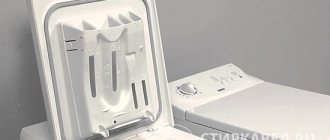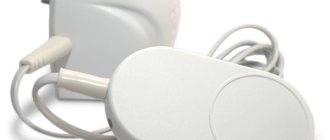It is difficult to imagine modern life without a washing machine: after all, it makes life much easier and saves time. Most often it is installed in the bathroom, but when the bathroom is too small, problems arise with the layout. How will a washing machine feel in the kitchen? Before choosing its final location, let's get acquainted with all the pros and cons of such placement.
Advantages
The most important advantage: the bathroom does not take up precious space, and it becomes freer. But besides this, there are several more advantages that you don’t immediately think about.
Safety
According to fire safety rules, electrical appliances should not be placed in rooms with high humidity, which is the bathroom. The kitchen is a different matter, here the humidity is much lower, and most often there is a window that provides active air circulation.
Work zone
Usually the washing machine is hidden behind the facade or simply covered with a countertop. In both cases, a new work surface appears, which will never be superfluous in the kitchen.
Communications
It is convenient to install the washing machine in the kitchen, since the main communications are already there: both water supply and sewerage - there is no need to install anything additional. You just have to clarify how to connect the electrical wiring, because the machine requires a dedicated line.
Wash anytime
You can do laundry in the kitchen at any time, regardless of whether anyone is taking a bath. On the other hand, noise during spinning and draining can interfere with an evening family meal or watching TV.
But, according to reviews, the same hood is louder than a washing machine. You can run the wash at night: this way the machine will not disturb anyone, and your energy bills will be lower.
Selecting a location
When choosing the location of a household appliance, it is wise to give preference to a place in close proximity to the kitchen sink . This will simplify connecting the machine to communications for draining and collecting water.
If this is not possible, you should not only take additional care of the connecting hoses for extension, but also think about how to hide them. It is better to install the machine away from the oven, otherwise it is important to ensure good thermal insulation.
The best option is to mount the machine under a common countertop or place it behind a separate door. This allows not only to perfectly fit the unit into the interior, but also to reduce the noise level.
Advice. If there are small children at home, equip the closet with a special lock to prevent them from getting to the machine and washing powder.
The top-loading unit can be conveniently placed in the corner of the room.
Flaws
Everything has both advantages and disadvantages. And the washing machine in the kitchen is no exception. But basically, the disadvantages are not related to the machine itself, but to its “extras”.
Storing dirty laundry
Dirty laundry has an odor, and if you store it in the kitchen, it will also absorb kitchen odors. And this means that it will have to be carried to the kitchen either from the bathroom or from another room. Some people find this very inconvenient - although in fact, there is nothing critical about it.
Storing powder in the kitchen
With powder the situation is more complicated:
- it can be scattered, which is undesirable in the room where food is prepared;
- it gives off a smell that is harmful to breathe.
There are several ways out of this situation:
- store washing powder in another room;
- switch to liquid laundry detergents;
- Store the powder in a container with a good tight lid.
ADVICE. It is most convenient to store the powder in the kitchen either next to the machine or under the sink.
Open door
After washing, the machine door should be opened and the drum ventilated to prevent mold from growing in the appliance. This can interfere with passage, especially if the machine is built-in - after all, you need to open not only the machine door, but also the cabinet door.
Difficulty of change
Once the machine is already installed, it is difficult to move it somewhere else, since pipes and electrical wires are laid. But this applies not only to the kitchen, but also to other rooms.
Spoils the appearance
This does not apply to all washing machines, but only those not hidden behind the facade. Dirty laundry stored inside looks especially unsightly.
ADVICE. To make the machine look neater, you should match it to the kitchen facades, or decorate it with vinyl stickers of the same color.
If both options are not suitable, then the machine is hidden behind a beautiful matching curtain. This is especially true for kitchens in the style of Provence, Country and others.
Front loading or top loading?
Modern manufacturers produce only two main types of such household appliances. The first type includes models with a horizontal drum arrangement. On the front of such a machine there is a special window through which laundry is loaded.
The second type includes models with a vertically located drum. Despite the external compactness of such devices, they have a larger volume. In addition, kitchens for a top-loading washing machine will have to be equipped with an additional cabinet with a folding countertop. This can not only spoil the overall appearance of the headset, but also minimize all attempts to optimize the space.
Taking into account all of the above, we can conclude that for the kitchen it is better to choose front-loading models. By the way, relatively recently machines have appeared on sale, prudently equipped with the elements necessary for hidden installation. But due to the presence of anti-vibration shock absorbers and hinges for fastening furniture facades, the cost of such units is an order of magnitude higher than usual.
Adviсe
There are several ways to reduce the disadvantages of placing a washing machine in the kitchen:
- if it interferes with the meal with its noise, then you can postpone the washing to night time. And it’s best to adjust its legs so that the equipment is installed perfectly level - so it will be practically silent;
- The noise is also affected by the floor covering on which the machine stands. It is worth giving preference to ceramic tiles - the quietest material. But if there is laminate on the floor, then there is a high probability that the neighbors will immediately know when your machine starts spinning the laundry;
- It is best to place the washing machine next to the dishwasher and sink, thus creating a “wet” corner. This makes it more convenient to supply water, and it will be easier to clean when everything is at hand. In a corner kitchen, for ergonomic reasons, the dishwasher is placed to the right of the sink, and the washing machine is placed to the left.
There are several ways to install appliances in the kitchen. They have no significant differences in characteristics, advantages or disadvantages.
Washing machine in the kitchen with different layouts
Here are some interesting ideas on how to beautifully arrange a stationary or built-in washing machine.
- Corner kitchens with washing machine.
- Linear (straight) layout.
- U-shaped kitchen with SM.
- Double row.
Full embedding
A built-in machine in the kitchen is beautiful because it itself is not visible, everything is hidden behind the facades. The unity of style is maintained, the room seems spacious and tidy. This is one of the most common options for installing equipment, but there are several disadvantages :
- the choice of built-in machines is not at all wide;
- the cost of such equipment is significantly higher than standard analogues;
- Difficult to access if repairs are required.
This option is suitable for owners of small kitchens, for example, in Khrushchev-era apartments, when it is necessary to visually expand the space.
Manufacturers of built-in appliances clearly indicate the dimensions of cabinets for installation in their instructions. Below you will find a diagram for installing the Candy CWB 1372DN1-07 washing machine.
And here is a diagram for installing a Whirlpool AWOC 0614 washing machine:
There is a built-in cabinet. This allows you to raise the machine to the desired height, without losing precious space, since there will be storage boxes or other equipment, for example, a microwave oven, under and above it.
Is it possible to build in a free-standing automatic machine?
Since a built-in washing machine is quite expensive, buyers often have the question: “Is it possible to build in a regular automatic machine?” It is possible, and in several ways:
- Install a compact automatic machine in one of the empty cabinets. Compact models are lower and narrower than their counterparts both in height and depth, so there will be no problems with placement. The only thing worth considering is that such units are quite light, which means they will vibrate strongly during spinning.
- Hide a regular automatic machine under the countertop, having first removed the lid from it. Perhaps this is the simplest and most convenient way to embed a regular model. Just keep in mind that the covers are not removable on all models. Without a removable cover, you can find machines from the Samsung and Hotpoint-Ariston brands, for example, Samsung WF600B0BCWQ and the entire Aqualtis series.
- A free-standing machine can be built in completely, that is, it can be installed deep into the cabinet, and a door can be installed separately in front. Or you can leave the front panel open. In the first case, the equipment will become one with the set; in the second, it will be easier to put and remove laundry into the machine (you won’t have to first open the door, then the hatch, and then close everything in the reverse order).
- Make a custom-made set of non-standard sizes directly for existing equipment. Even vertical models can be built in this way.
Partial embedding
If you don’t want to overpay for built-in appliances, you can put a regular front-loading washing machine in the kitchen and cover it with a countertop. Here it is worth considering its height, but the technique is quite standard - about 85 centimeters. The height of a standard tabletop is the same.
If a couple of centimeters are still missing, then you can remove the top cover of the washer: to do this, you need to unscrew a couple of screws on the back - this will give you a few centimeters. But then it is advisable to cover this area with either film or thin plastic.
There are two methods for partial embedding:
- without door;
- with door.
Let's consider these methods in more detail.
Without door
The essence of this arrangement is that the washing machine is simply placed next to the kitchen unit and covered with a countertop. In this case, it is important to attach the tabletop to the wall, and not just lean it on the equipment.
It turns out that the washing machine is closed only at the top, which provides a work area in the kitchen, but the machine is visible from the side. This is a plus, since it’s easier to take out and put down laundry, although aesthetically it doesn’t always look beautiful. This is where the advice of covering the equipment with a curtain, matching it, or decorating it with a vinyl sticker comes in handy.
This arrangement ensures mobility: if the machine breaks down, it’s easy to move it away and then push it back in. Therefore, this method is suitable for those for whom the main priority is convenience rather than beauty.
An example of such embedding can be seen in the photo.
With door
If you want to close the car, then a built-in one with a door is perfect. In principle, there is no actual installation here: the machine is simply placed in the kitchen unit. It is advisable to place it on the floor because the machine may shake. If this is not possible, then you should strengthen the base as much as possible: place bricks or solid wood boards under it, and also reinforce it with corners.
Front washing machine: how to properly install and integrate a washing machine under the countertop?
Of course, you can’t install a standard machine like this, because it won’t fit. It is worth choosing among compact options with a depth of 45–50 cm. Their choice, unfortunately, is as small as that of built-in models, but they are more affordable.
With such an arrangement, you need to watch out for three things :
- a tray for powder - so that it does not rest against the hinges of the door of the unit, but extends out enough to add powder or pour in detergent;
- the location of the door - it is desirable that the car hatch and the door of the set open in one direction, otherwise it will be inconvenient to take out and put down laundry;
- having a margin of 2-3 centimeters on each side to prevent noise from washing.
Moreover, it is advisable to remove the back panel of the headset for air circulation and ventilation of the machine to avoid excess dampness.
Under the sink
Residents of Khrushchev-era apartment buildings sometimes take this step - installing a washing machine under the sink. This may not be the best solution, but in conditions of severe space saving, it has its place.
In this case, you need to pay special attention to the choice of washing machine under the sink:
- the height of the machine should be no more than 70 cm. Otherwise, it will be extremely difficult for small people and children to reach the sink, and they will have to substitute a stool;
- The depth of the washing machine built under the sink should be approximately 50 cm. In this case, it is necessary to take into account the gap behind the rear wall for communications and a flat siphon.
Sinks above the washing machine - Santekhniks.ru
You also need to choose the right sink. It should be a “water lily”, with a maximum height of 20 cm. For safety reasons, the drain should not touch the washing machine.
The advantages of such placement include saving space. Some even consider this layout stylish and modern. However, disadvantages here.
Firstly , these are the disadvantages associated with the small dimensions of the washing machine - neither a down jacket nor a blanket can be washed.
Secondly , the drain in a “lily pad” sink is prone to more frequent blockages.
Thirdly , for installation you will need a special siphon, which is not so easy to find.
Fourthly , there is a risk of water getting on the control board, which will lead to equipment breakdown.
Washing machine in the kitchen
Placement in a cabinet
A common way of arranging a kitchen set is to divide it into two parts, where wall cabinets, a stove, and a countertop are included in the first part, and the second independent part includes a cabinet with a sink and a machine, placed along the side wall.
This arrangement contributes to the convenience of connecting the unit and a long service life.
Under the windowsill
If the window opening is large enough, install a wide tabletop. A washing machine will fit perfectly under it, and you will get an additional work surface or a small dining table.
However, for this, the panel must be large, otherwise all the space under it will be occupied. In addition, this space is often reserved for batteries - redevelopment will probably be required.
Under the table top
In this case, the machine is placed in one of the niches in the lower section. If this is the case with a ready-made headset, then there is a possibility of problems with aesthetic installation (for example, there will be large gaps or it will be extremely difficult to connect communications).
Therefore, we would recommend considering this option when ordering a new headset. Then, even at the design stage, you can select a niche of the required size for the machine with millimeter accuracy.
High installation
Connecting the washing machine is not everything. You also need to consider the convenience of subsequent use.
We recommend placing the machine higher up, not on the floor, to make it easier to load things. A good example is in this photo.
This way you won't have to bend over every time you need to wash.











